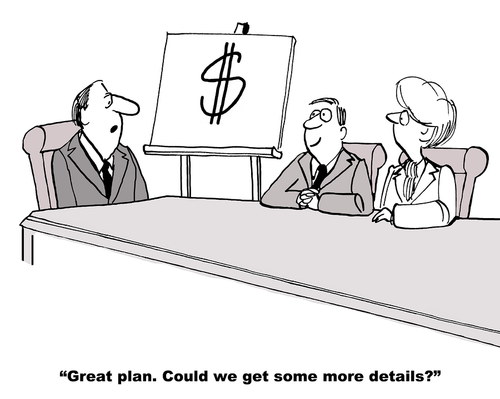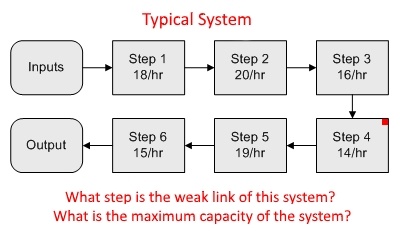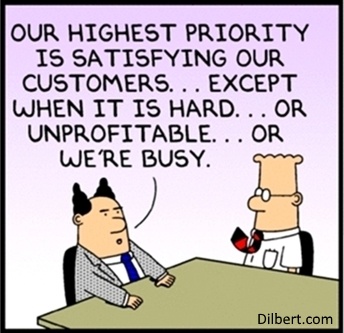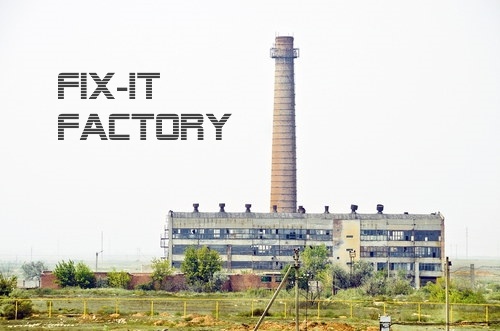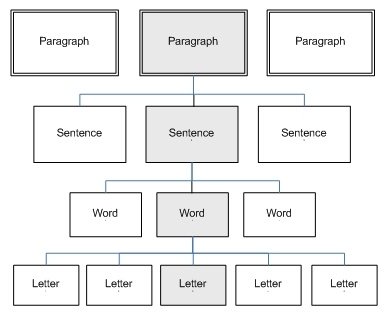A business is made up of people, products, and processes organized to profitably find and keep customers. Many companies fail because owners and managers are unable to create effective business processes that accomplish this fundamental objective.
So, what exactly is a business process? And how can you create processes that will help your company achieve greater customer loyalty, profitability, and growth?
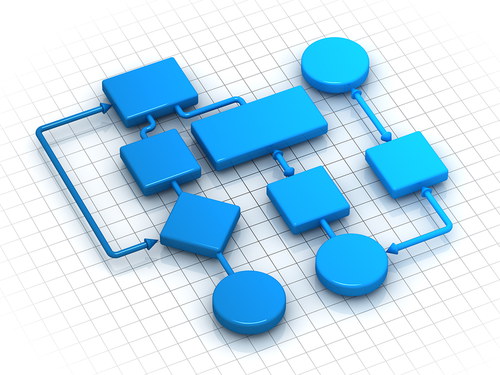
Simple Definitions
There are business process experts who get deep in the weeds when defining a business process or trying to distinguish it from a business procedure or a business system. However, for entrepreneurs and owners of small to midsize businesses, a few simple definitions will suffice for our discussion.
- Business Procedure – a sequence of actions taken to accomplish a task (emphasis on following steps in a specified order).
- Business Process – a series of ordered activities that transform inputs into higher-value outputs (emphasis on transforming materials or information into a product or service).
- Business System – a group of interacting, interrelated, or interdependent elements forming a unified whole (emphasis on related parts working together for a desired outcome).
A Process is Just a Recipe
As a business owner or manager, you may use these terms interchangeably. They are all business activities designed to produce a specific, pre-determined, and consistent result. They include your processes for marketing and sales, hiring and training employees, customer service, production, order fulfillment, accounting, and many more, some unique to your industry or company.
Business systems and processes—whether in the store, the office, or the workshop—are your unique recipes for getting work done. They are governed by the Law of Cause and Effect. The result (effect) of a business process is determined by the ingredients used (e.g., forms, checklists, materials, supplies, equipment, software, people, and so forth) and the procedure followed (cause). The only way to get a better process result is to improve the ingredients or the procedure of the recipe.
For example, when you carefully follow the detailed instructions of a chocolate cake recipe, you get the same result every time. However, we all agree there are chocolate cakes and then there are CHOCOLATE CAKES! (e.g., Chocolate Thunder). They may go by the same name, but the unique recipe makes all the difference.
The same is true with your recipe for generating sales leads or hiring the best people. A little change in ingredients or procedures can give you far superior results!
Correctly designed, your business systems and processes support the mission, strategy, and goals of your organization. While people may come and go, the successful recipes you have created remain constant. Furthermore, the better your recipes are, the greater the customer loyalty, profitability, and growth you will enjoy!
Simply put, 100% of your business is made up of systems and processes (recipes) that can be managed and improved by applying correct principles to fine-tune 1) the ingredients or 2) the procedures. There is no other way!
Three Types of Business Processes
Effective systems and processes are the essential building blocks of your company. There are three general types to consider:
- Management processes include planning, organizing, controlling, and leading—the activities for governing your business (e.g., developing strategy, management meetings, and board of directors or advisors).
- Operational Processes constitute your core business functions and create the primary value stream for customers (e.g., lead generation, sales, purchasing, production, order- fulfillment, shipping, and customer service).
- Supporting processes uphold and sustain the core processes (e.g., accounting, hiring, information systems, safety, and custodial).
Most business systems and processes are unique to your company (like fingerprints) and differentiate you from all other companies unless you are a franchise. They include sub-systems or sub-processes that focus on the details of your business activities. For example, a marketing process has a sub-process called lead generation, which has sub-processes such as print advertising, radio, social media, or a website. It is in the details—the sub-systems and processes—that profit dollars are made or lost!
Good business systems and processes have three primary purposes: 1) to attract customers, exceed their expectations, and transform them into loyal fans, 2) to eliminate operational waste and inefficiencies that rob profit and 3) to create differentiation and domination in your target market.
Michael Gerber, the author of E-Myth Revisited, teaches, “Organize around business functions, not people. Build systems [and processes] within each business function. Let systems run the business and people run the systems. People come and go but the systems [and processes] remain constant.”
Describing a Process: Procedure vs. Checklist
When the steps of a task are performed in a specific order, the term “sequential steps” or “procedure” is used. For example, in a furniture shop, you first cut the wood, then sand the wood, and finally paint the wood. Doing these three things in the right order is essential. Your finished product would be unacceptable if you painted the wood before you sanded and prepared it.
A flowchart diagram with boxes and arrows—indicating steps, decision points, branches, and loops—sometimes makes it easier to describe a multi-path process than does a written procedure. Using the furniture example, if the wood has a rough edge when it arrives at painting, your decision is to reject the wood and send it back to the preparation stage. There it is re-sanded and returned to painting. After painting, a branch in the process might also send different colors of wood to separate pallets for storage.
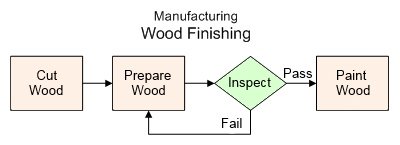
When the steps in a process can be performed in any order, a simple “checklist” is all that is needed. For example, your office custodian might empty the trash, dust the furniture, and vacuum the floor. However, it doesn’t really matter in what order the tasks are completed. Checklists are easy business systems that do not require flowcharts and can usually be created rather quickly.
Remember: While much thought, planning, and experimentation may go into developing a high-performance business system or process (see Your First Business Improvement Workshop), everything learned is eventually reduced to a single procedure or checklist that is used by the people who operate the system. Their responsibility is to follow that procedure with exactness until the system is improved. If you encourage and reward innovation, system operators will also drive the improvement process.
Processes Are for Customers
A primary purpose of your business processes is to provide value for customers—to transform information or material into something that customers want, and which meets their specifications and expectations. Customers can be those who ultimately buy your products or services; however, business processes also serve the similar needs of your internal customers (see Your Five Different Customers).
For example, in your business operations, the next step in a business process is the customer of the previous step in that process. In an assembly line, station two is the internal customer of station one. The order-fulfillment department is the customer of the order-processing department. The sales team is a customer of the advertising or lead generation team. Each “customer” in a chain of business activities looks for added value, and also wants their specifications and expectations to be met.
In addition, employees are important customers of the business. They too have specifications (e.g. work hours, wages, and benefits) and expectations (e.g., rewarding assignments and opportunities for advancement). Whether spoken or not, if you fail to meet their requirements, they will eventually go somewhere else. Good business processes support the learning and growth of your people and inspire their loyalty.
All of your business processes must deliver four basic things to its external and internal customers: 1) quality—low defects, does what is supposed to do, 2) speed—on schedule, meets deadlines, no delay, 3) low cost—high perceived value, competitively priced, and 4) pleasurable buying experience—no hassle, “killer customer care.”
Business Process Development
Learning how to develop good business processes is the Master Skill of the entrepreneur. All business functions—marketing, finance, and operations—fall within the scope of this single skill mastery. What’s more, the true value of your business is found in the maturity of its business processes—their ability to produce desired results consistently. (How would you and others grade your current business systems and processes?)

Below are ten characteristics of an effective, efficient, and even exceptional business system or process:
- The process is built with the customer in mind. (Does this business system or process help turn your customers into loyal followers by meeting or exceeding their expectations? Does it help your workers perform at their best and get top results, even when you’re not around?)
- The process represents “best practices” or your best-known way of doing something. (Are you getting less than 1% errors? Is the process as fast as it could be? Be honest. Is this the best you can do, or could you make the process better?)
- The business process is designed with one primary purpose (more than one purpose usually means that processes are wrongly combined). In addition, the process has no unnecessary steps and little or no idle time between steps. (Is the process stable, steady, and paced with sales orders and fulfillment? Are the process goals aligned with your company goals?)
- The system or process has an owner or team leader. (Who is accountable for and reports the results of the process? Is the person rewarded for exceeding performance standards or making improvements?)
- There is ongoing and updated documentation on how to execute the process properly, including the handling of details and exceptions. (Do workers fully understand the process and can easily repeat it with consistent results? Have you created a winning recipe?)
- The process is as simple as possible to get the job done, but not simpler. (Can you lesson complexity, customization, and exceptions in products and services? Can you reduce the physical path, clutter, barriers, and distractions? Can you drop unprofitable product-lines or services?)
- There is a sufficient focus on system details to eliminate most bottlenecks, inefficiencies, delays, mistakes, defects, and rework. (Every process has waste. Have you reduced it to a minimum? Do you accumulate defects for later handling or do you properly fix problems in the process as they occur?)
- The business system is not hampered by poor planning (lack of materials or labor) or stop-start work-flow as people switch between processes. (Are your workers losing productivity or making excessive errors caused by shifting assignments, multitasking, being “spread too thin,” or “wearing too many hats”?)
- The system has performance standards, and results are measured. (Are you “managing by the numbers” for maximum profit? Do you celebrate success?)
- Workers get ongoing feedback about system-performance and are recognized or rewarded for exceptional results. (Do people always know how they are performing in relation to the goal? Is feedback self-administered, and in real-time like a sporting event? Simple tip: To improve performance, increase the frequency of the feedback.)
Quality + Speed = Low Cost
By creating business processes that have minimal mistakes, defects, and rework (quality), you will reduce waste and increases process speed. By eliminating delay, downtime, and other speed bumps, you will boost sales throughput. This powerful one-two punch of quality and speed will give you the lowest possible operational costs and provide your customers with the greatest value.
Outstanding business systems and processes are the “magic formula” for success! Superior quality and speed are the “secret sauce” that will wow customers, boost profit, blow the competition away, and make your company remarkable!
Wrapping Up
Well-designed business systems and processes increase efficiency, accomplish objectives, and give customers what they want every single time. They are your answer to weak sales growth, customer dissatisfaction, poor performance/productivity, waste of resources, employee turnover, excessive costs, slow cash flow, low profit margins, daily frustration, and every other business problem.
Whether in the store, the office, or the workshop, developing effective business systems and processes begins with good system design. After creating a flowchart or checklist, and acquiring the components necessary to operate the system, you now focus on improving its quality and speed. Measuring system-performance provides feedback for making adjustments and improvements.
More specifically, each step in the process flowchart contributes value to the customer. The process generates output that meets quality standards, with no accumulation of rejects or rework. The workload is level, uses standardized tasks, and is paced with the input of sales orders. Bottlenecks that delay order completion are eliminated. “Speed bumps” such as clutter, poor layout, and downtime are minimized. Employees are well-trained and incentivized when possible. People and systems learn and improve from the ongoing feedback of process results.
So, what exactly is a business process, and why should you care (a lot)?
In the game of work, good systems and processes embody your distinctive business strategy. They are your means to increase customer value and product demand. They enable you to differentiate yourself in a crowded marketplace. They help you maximize efficiency for greater profit, more personal income, and the ability to share financial rewards with others. In addition to people and products, processes give your company a unique identity and place in the world.
Is it worth it to learn the Master Skill of system development? A thousand times, “YES”!
There is an art and a science to creating exceptional business systems and processes and growing a remarkable business enterprise. I invite you to check out the Box Theory™ Way today and discover our eCourse and breakthrough business-process software, specially designed for small to mid-size businesses.


